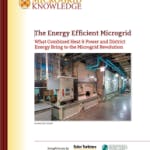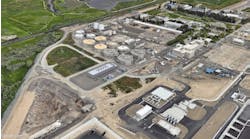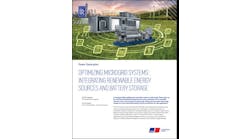Think Microgrid: Why Government Leaders Are on a Serious Quest to Build Microgrids
The following is an excerpt from our latest Think Microgrid report, The Energy Efficient Microgrid
Simple microgrids have existed for more than 100 years, going back to Thomas Edison. Until recently, North American energy planners viewed microgrids as largely niche energy projects, most likely to be found on college campuses, islands or remote Alaskan and Canadian outposts. However, North America now views microgrids more broadly, as the answer to very pressing energy needs.
Technological advances, falling fuel costs – and some very bad weather – brought about this change in thinking.
The 2012 Superstorm Sandy will go down in history as the wake-up call that accelerated America’s move toward a distributed energy grid: a system that increasingly replaces large central energy facilities with on-site, local energy.
Governments and energy leaders began a serious quest to develop a more storm-resilient electric system after Sandy knocked out power to over eight million homes – in some cases for weeks – leaving large swaths of key cities darkened in New England, New Jersey, New York, Ontario and Quebec.
But in the darkness there were pinpoints of light. These were the microgrids that were able to continue operating. As wires and poles toppled, the microgrids escaped the cascading power failure by taking advantage of one of their key features – the ability to ‘island’ or separate electrically from the main grid. The buildings within the microgrid instead received power and heat from on-site generators. (See Princeton University’s Microgrid: How to Partner, not Part from the Grid).
Microgrids not only kept the lights on for the buildings they serve, but also acted as a power oasis. For example, New York University’s main campus served as a place of refuge for New Yorkers forced to evacuate from their homes. New York City officials were able to use the campus as a command post. The campus islanded from the main grid and never lost its heating, cooling or electricity thanks to its 10 MW Solar Turbines combined cycle CHP system.[1]
Sikorsky Aircraft, a unit of United Technologies Corporation (UTC) in Connecticut, also stayed up and running because of its 10.7 MW Solar Turbines natural gas-fired CHP system. Sikorsky helped the relief effort by ferrying rescue workers free of charge via helicopter, and also by delivering necessities to a hospital on Staten Island.
Solar Turbines checked in with hospitals, universities, manufacturers and others that use the company’s CHP gas turbines to see how they fared. Here’s what customers told them.
New York University (NYU) NYU operates a 10-MW CHP plant in New York City with two 5-MW Taurus 60 gas turbine generator sets. The plant system serves power and steam to a major portion of the campus, including the larger buildings, as well as most of the Washington Square campus in Manhattan. The units operated well during the storm. “Our cogen is up and running,” said John J. Bradley, the university’s assistant vice president for sustainability, energy and technical services.”
Danbury Hospital Danbury Hospital in southwestern Connecticut is a 371 bed comprehensive regional medical center with Solar Turbines’ 4.5 MW Mercury 50 gas turbine and three megawatts of standby generators. During the storm, the facility operated without any loss of power and despite most of the businesses in the surrounding area being without power for several days, Danbury Hospital still had lights and heat, according to Kevin Naurus, plant manager. The CHP facility enabled the hospital to be fully functional during the storm and continued conducting business and providing the critical and necessary health care necessary for patients.
Hunterdon Developmental Center The Hunterdon Cogeneration facility, located in Clinton, New Jersey, is powered by a 4.5 MW Centaur 50 gas turbine generator set from Solar Turbines. Operated by Noresco, the turbines provide power and heat to both a health services complex with living facilities and a correctional facility. During the storm, power was out in the area for several days, but the CHP plant was able to operate in island mode, continuing to power the complex.
Pepco Midtown Thermal Energy Plant Pepco’s Atlantic City, New Jersey’s 5.7 MW CHP plant is powered by a Taurus 60 gas turbine generator set and is located only a few blocks from the Atlantic Ocean – directly in the center of Hurricane Sandy. John Howell, Pepco’s maintenance manager, who was at the facility during the storm, said that the plant operated extremely well and was able to continue providing needed power to the local area, including chilling and heating. The Pepco plant provides power to high profile, mission critical facilities, such as Caesars, Bally’s Park Place, Bally’s Wild West, Claridges, Trump Plaza, Trump Taj Mahal, and the Atlantic City Convention Center. Many of these hotels helped house their own employees, local residents, and travelers during and after the storm.
Of course, wide-scale power outages are not new to North America. The decade preceding Sandy saw its share of major disruptions, among them the Northeast Blackout of 2003, the Hurricanes Katrina and Rita in 2005 and Hurricane Irene and the Northeast’s freak Halloween snowstorm in 2011.
After each event, the power industry vowed to harden the grid against repeat catastrophes, only to find its attention and resources soon redirected elsewhere. But with the devastation of the Superstorm Sandy, “this cycle of forgetfulness was finally broken,” says the Clean Energy Group in its September 2014 report, “Resilient Power: Evolution of a New Clean Energy Strategy to Meet Severe Weather Threat.”
The CEG report goes on to say:
For the first time, the conversation about resilient power did not die down after the storm passed. The public was angry; utilities, hit hard by the storm and struggling to restore power to their service areas, acknowledged that the electric grid was not built to withstand extreme weather events. Sandy was connected in the public dialogue with climate change and its associated risks to cause increasingly severe weather patterns—people began to talk about being better prepared for future storms.
Interested in reading more of this report? Download The Energy Efficient Microgrid at no charge courtesy of Solar Turbines and the International District Energy Association.







